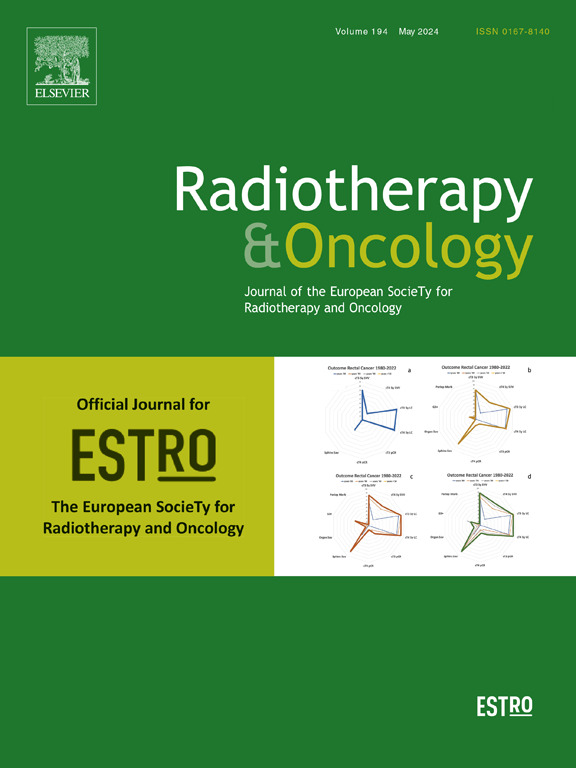Acute toxicity and quality of life after margin reduction using a sub-fractionation workflow for stereotactic radiotherapy of localized prostate cancer on a 1.5 Tesla MR-linac
IF 4.9
1区 医学
Q1 ONCOLOGY
引用次数: 0
Abstract
Background and purpose
A sub-fractionation workflow to correct for intrafraction motion in localized prostate cancer radiotherapy was implemented at our center, allowing for PTV margin reduction from isotropic 5 mm to 2 mm in cranio-caudal and left-right directions and 3 mm in the anterior-posterior direction. The purpose of this study was to assess differences in acute toxicity before and after margin reduction.
Materials and methods
Included patients were treated with 36.25 Gy in five fractions on a 1.5 T MR-linac, with PTV margins of 5 mm (standard margins) or 2-3 mm (tight margins). The primary endpoint was acute (90 days post-RT) toxicity. Physician-reported toxicity was measured by maximum CTCAE version 5.0 genitourinary (GU) and gastrointestinal (GI) scores. Patient reported toxicity was a secondary endpoint, assessed through EPIC-26 urinary and bowel domain scores. Groups were balanced through propensity score matching after multiple imputation using chained equations. Pearson’s Chi-squared tests were used to analyze CTCAE scores and Wilcoxon rank sum tests to analyze EPIC-26 scores.
Results
299 eligible patients were identified (193 and 106 in the tight and standard margin groups, respectively). After matching, 212 patients (106 per treatment group) were available for assessment. No statistically significant between-group differences in physician-reported toxicity were observed at any follow-up point. Patient-reported urinary irritative/obstructive quality of life was statistically, but not clinically, significantly higher after one month. Overall, scores declined during treatment and one month post-RT, but returned to baseline levels three months post-RT.
Conclusion
Margin reduction below 5 mm did not seem to reduce acute toxicity after radiotherapy with a stereotactic body radiotherapy (SBRT) treatment schedule in localized prostate cancer. The introduction of real-time comprehensive motion management with prostate gating could further lower GU and GI toxicity and ameliorate treatment related quality of life.
应用亚分步工作流程在1.5特斯拉磁共振直线加速器上对局限性前列腺癌进行立体定向放疗后的急性毒性和生活质量。
背景与目的:本中心实施了一种用于纠正局限性前列腺癌放射治疗中抽离内运动的亚分割工作流程,允许PTV边缘在颅尾和左右方向从各向同性5mm减少到2mm,在前后方向减少3mm。本研究的目的是评估切缘缩小前后急性毒性的差异。材料和方法:纳入的患者在1.5 T MR-linac上接受五组36.25 Gy的治疗,PTV边缘为5 mm(标准边缘)或2-3 mm(紧边缘)。主要终点是急性(放疗后90天)毒性。通过CTCAE 5.0版泌尿生殖系统(GU)和胃肠道(GI)评分的最大值来测量医生报告的毒性。患者报告的毒性是次要终点,通过EPIC-26泌尿和肠域评分进行评估。使用链式方程进行多次归算后,通过倾向得分匹配来平衡各组。CTCAE评分采用Pearson卡方检验,EPIC-26评分采用Wilcoxon秩和检验。结果:299例符合条件的患者被确定(窄切缘组193例,标准切缘组106例)。匹配后,212例患者(每个治疗组106例)可用于评估。在任何随访点,均未观察到两组间医师报告的毒性差异有统计学意义。1个月后,患者报告的泌尿刺激/梗阻性生活质量在统计学上有显著提高,但在临床上没有。总体而言,在治疗期间和放疗后一个月,评分下降,但在放疗后三个月恢复到基线水平。结论:立体定向体放疗(SBRT)治疗局限性前列腺癌后,切缘缩小至5mm以下似乎不能降低急性毒性。采用前列腺门控的实时综合运动管理可以进一步降低GU和GI毒性,改善治疗相关的生活质量。
本文章由计算机程序翻译,如有差异,请以英文原文为准。
求助全文
约1分钟内获得全文
求助全文
来源期刊

Radiotherapy and Oncology
医学-核医学
CiteScore
10.30
自引率
10.50%
发文量
2445
审稿时长
45 days
期刊介绍:
Radiotherapy and Oncology publishes papers describing original research as well as review articles. It covers areas of interest relating to radiation oncology. This includes: clinical radiotherapy, combined modality treatment, translational studies, epidemiological outcomes, imaging, dosimetry, and radiation therapy planning, experimental work in radiobiology, chemobiology, hyperthermia and tumour biology, as well as data science in radiation oncology and physics aspects relevant to oncology.Papers on more general aspects of interest to the radiation oncologist including chemotherapy, surgery and immunology are also published.
 求助内容:
求助内容: 应助结果提醒方式:
应助结果提醒方式:


